Introduction
The world of Artificial Intelligence (AI) is changing so fast that it is hard to keep up. A wave, no tsunami of AI marketing tools is sweeping through marketing that will change the face of marketing forever. There are already a staggering number of marketing tools available to marketers. AI is shaking up the market. Whilst leading players urgently look to engineer AI features into their existing products, challenger brands look to gain competitive advantage and new visionary players emerge. And if that is not disruptive in itself, new categories emerge, driven by AI like Forrester’s AI Customer Intelligence (AICI) platform category.
So, how do you keep ahead of the game and understand what AI marketing tools are right for your martech stack? First, you need to understand the martech stack.
The martech stack today
The concept of the martech stack has matured nicely and marketers can now identify and add marketing tools to the stack with the knowledge of what role they play and that they play nicely together. This wasn’t always the case and central to this change has been the evolution of integrations.
The rise of APIs (application programming interfaces) in the early 2000s made it possible to develop more complex and sophisticated integrations, allowing different software applications to communicate with each other and share data. The growth of the marketing cloud-accelerated this further with centralised hubs, super-suites capable of automating many marketing functions in unison across mainstream marketing tools. Whilst this left many smaller challenger products or niche products out in the cold, the emergence of integration platforms in the last 15 years like Zapier has filled in the gaps.
The AI revolution is likely to advance with many waves of innovation and this revolution is just starting. It might feel overbearing as the hype, and also the noise surrounding AI is currently deafening. But this will calm down and we’ll all start to see the wood through the trees as this emerging technology matures.
For this reason, it is useful to look at AI marketing tools and the impact of AI on marketing with some sort of framework, the martech stack.
Today’s martech stack looks something like this.

The specific marketing tools and technologies that are included in each tier will vary depending on the needs of your business and they are vast in number, too many to list here. However, the tiers listed above provide a general framework for thinking about the Martech stack.
It is important to note that the Martech stack is not a linear progression. Businesses can start at any tier and build their stack up over time. However, it is important to integrate the different tiers of the MarTech stack so that data can flow seamlessly between them.
By understanding the different tiers of the MarTech stack, businesses can make more informed decisions about which tools and technologies to invest in. Let’s look at these in more detail.
The martech stack in detail
There are 6 tiers in the martech stack.
- Data Foundation
- Marketing Automation Platform
- Analytics and Insights
- Personalisation and engagement
- Marketing Applications
- Emerging Technology
Data Foundation
If the martech tools you use to identify customers, market to them, and convert them into customers were cars, then the data in your martech would be the fuel. Without good data, complete data and well-formatted data, you are going to struggle from the start to create any meaningful value. You could also do a lot of damage. This is why the data tier is foundational, it impacts the ROI of every other tool in your martech stack.
This foundation includes the tools and technologies used to collect, clean, enrich, store, and manage customer data. Your customer data will come from a variety of sources, such as websites, e-commerce platforms, CRMs, and zero-party data sources such as customer survey platforms. Mix in 3rd party data too and you have a complex data lake of billions of data points. At this point, you can sink or swim.
According to a study by McKinsey & Company, only 8% of companies are making the most commercial use of their customer data.
Given the amount of data that marketers have at their fingertips today, it might make sense to hand decisions and data wrangling on customer data over to Business Intelligence teams or data science teams. Gartners Marketing Technology Survey has identified a growing shift in the ownership of marketing databases, away from marketers. However, this comes with its challenges. Relying on other teams to produce your insights, your marketing audiences, segments etc would possibly slow you down and be influenced by other people’s interpretations.
How is AI having an impact?
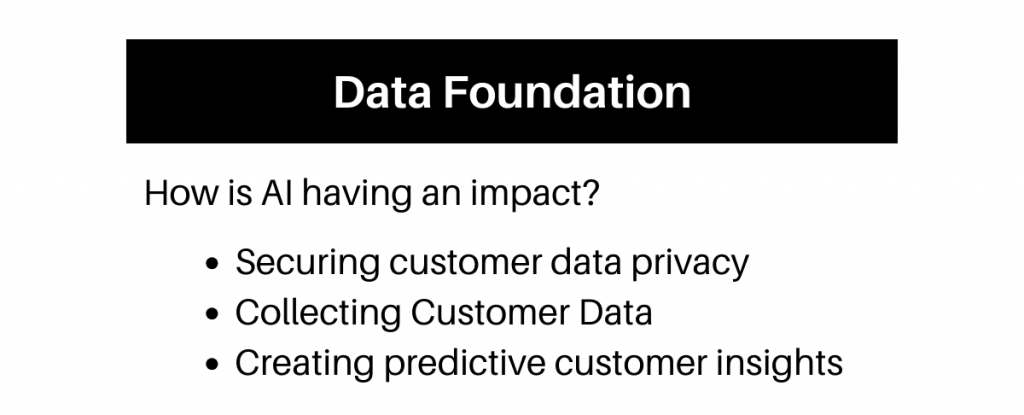
- Securing customer data privacy – Customers are acutely aware that brands hold personal data on them, and they expect brands to act responsibly with the data. However, consumers have read headlines far too many times about data breaches that they have become untrusting of brands and are withholding permissions. AI can be used to develop and implement measures to protect customer data. For example, AI can be used to identify and remove sensitive data from customer records and encrypt customer data.
- Collecting Customer Data – AI is making it possible for businesses to collect and store more data than ever before. This is due to the fact that AI can help to automate many of the tasks involved in data collection and storage.
- Creating predictive customer insights – With greater data resources, the use of predictive and prescriptive insights to know the next best marketing actions will grow in practice in the coming years.
McKinsey & Company found that companies that use predictive analytics to personalize their marketing campaigns see an average increase in revenue of 10% to 15%. Therefore, it’s no wonder Starbucks already use predictive analytics to personalize its marketing messages and offers for its customers. Just think how powerful a tool that would be for you as a marketer if you knew which product your customers wanted and when they wanted it.
The barrier until now has been the volume of data. AI can crunch that data, analyzing large volumes of customer data to identify patterns and trends that would be impossible to detect manually. Separating this signal from the noise, then allows AI to predict customer intent based on what it has seen in the data of others displaying similar patterns of behaviour.
“Predictive and prescriptive analytics are becoming essential tools for marketers who want to improve their campaign performance. These tools can help marketers to identify the right customers, target them with the right messages, and measure the results of their campaigns more effectively.”
Gartner
Marketing Automation Platforms
Next up, Marketing Automation Platforms (MAPs), a tier dominated by big goliaths like Salesforce Marketing Cloud, Hubspot and Adobe Marketo Engage. This is the tier where you really start to make use of customer data. Automating marketing tasks and workflows and integrating other marketing tools. These workflows include gating content, email marketing, social media marketing and other lead-generation activities. Through lead nurturing automation, customer onboarding and in-life customer experience metrics. Your MAP will also enable you to introduce personalisation into your activity and given their full circle role, will also track your key performance indicators with instance reporting. MAPs really are at the heart of your marketing activity.
How is AI having an impact?
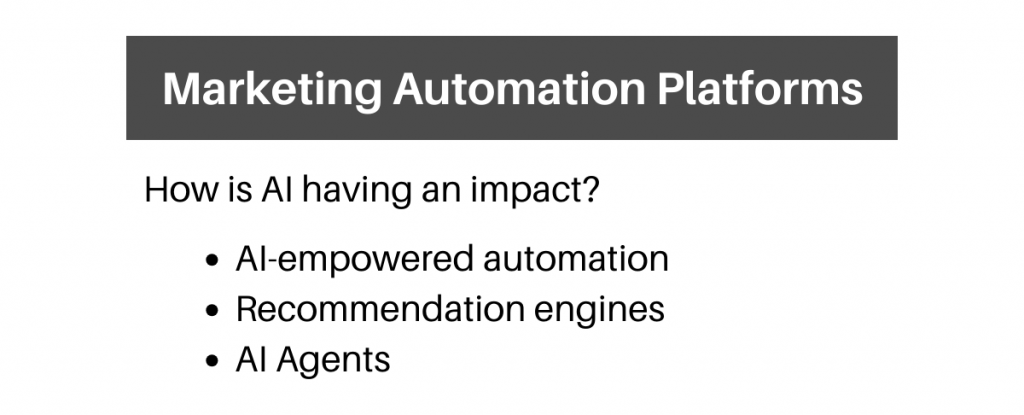
AI is having a significant impact on Marketing Automation Platforms (MAPs). AI-powered MAPs are already in the mainstream products and these marketing tools are helping the marketer with scalable personalisation and copywriting. However, what is more interesting is AI’s impact on the automation of workflows, recommendation engines and chatbots.
- AI-empowered automation – gone are the days of simple ‘if this, then that’ sequencing. AI has the power to do more of the thinking, which means infinite sequences. This has huge potential for the personalisation and relevance of recommendation engines,
- Recommendation engines – will be able to automate the next best actions based on real-time customer behaviours, with infinite sequences. Being able to process larger datasets incorporating more than just past purchase history will lead to higher conversion rates and more satisfied customers.
- AI Agents – This is an exciting area that I hope to write more on in future weeks. AI-powered chatbots can help your customers, website visitors and prospects find the help or information they need much faster. Reducing the effort required to interact with your brand only improves the customer experience, delivers higher conversions and delivers a more satisfying experience. These will become mainstream but for now, they appear in the emerging technology tier.
MAPs are also turning these benefits on their own customer experience. Hubspot recently launched Chatspot, an amazing, multi-talented co-pilot that will do your prospect research for you, analyse your competitor tech stack, write your copy and create your images. With templates for tasks that often only require a URL to be dropped in, it’s a huge marketing tool for the marketer. Disclosure: If you make a purchase, I receive a commission.
Analytics and Insights
Your third tier in the marketing stack should be Analytics and Insights. These marketing tools analyze marketing data and generate insights. Mediocre insights have plagued marketing teams for years but AI-superpowered insights are now available which take the hassle out of gathering and interpreting data. We’ve seen this coming online in tools like GA4. It was only in recent years that Google Analytics started to give more useful insights whilst for years making the user do the hard work. These insights should drive marketing campaigns and strategy decisions, not the subjective views of non-marketers in the decision-making chain of command.
How is AI having an impact?
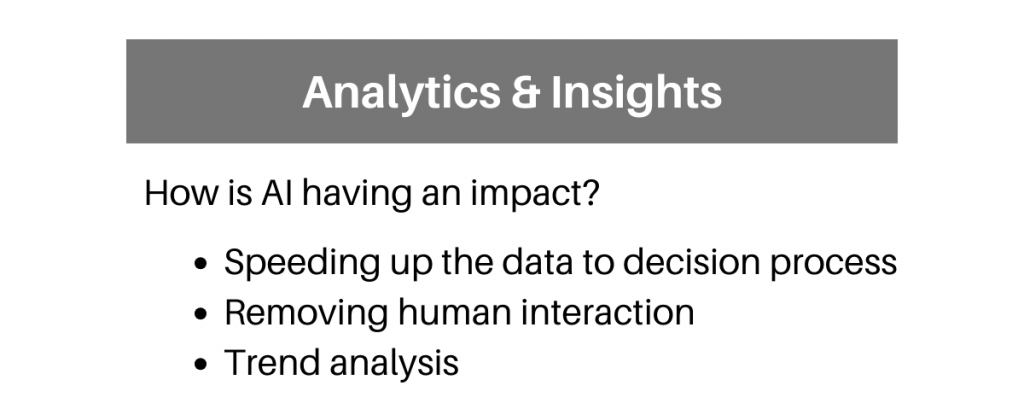
Analyzing larger volumes of data more quickly and efficiently than ever before is commercialising real-time marketing decisions as these marketing tools make this a reality.
- AI is speeding up the process of data to decisions. Using AI to analyze marketing data more quickly to provide accurate, packaged insights is a task that AI can do better and faster than humans. Embrace the advances of these AI marketing tools.
- Removing human interaction – AI removes the need for human interaction in some decisions but don’t worry, these are simple decisions, freeing up a marketer’s time to focus on more strategic initiatives.
- Trend analysis – AI can also identify trends and patterns in marketing data that would be difficult or impossible for humans to see. The result is deeper insights into your customers and marketing campaigns. The right actions can clearly turn ai-assisted insights into competitive advantage.
Personalisation and Engagement
The personalisation layer of the martech stack has been in full growth model for a while now and you’ll probably require a CDP (Customer Data Platform), DMP (Data Management Platform), or combination of the two to link the data tier to your engagement tier.
This tier of the martech stack includes the tools and technologies used to personalize marketing messages and experiences for individual customers. It includes marketing tools for email marketing, customer segmentation, landing page design and so much more.
Experience clouds like that of Adobe enable automation across the create, test, measure and iterate and AI efficiencies use algorithms to discover and deliver the offer that resonates most with each visitor every time.
How is AI having an impact?
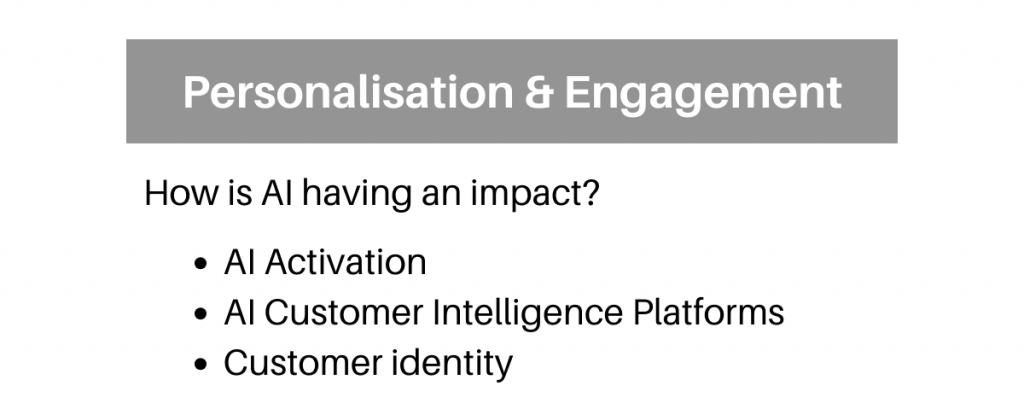
- AI Activation – expect to see more and more marketing activated by AI marketing tools at the point of engagement. Real-time engagement will require personalised content creation on the fly. Images, copy, multimedia, and voice-overs, are created in-the-moment, to deliver personalised experiences based on AI-assisted customer insights and audience segments. Being able to consider thousands of permutations, hidden in billions of data points however will require you to upgrade that CDP or DMP!
- AI Customer Intelligence Platforms – That upgrade will be an AICI (AI Customer Intelligence Platform) – With the death of the third-party cookie and the growth in first and third-party data, AICI deployments will grow. Forrester describes AICI platforms as enabling enterprises to use insights from data sourced externally (e.g. social, web, and/or data exchanges) and combine it with their own data (e.g. CRM, e-commerce) to look beyond a brand’s current customers’ needs and instead predict their future behaviours, preferences, and intent, rapidly delivering actionable insights as they emerge.
- Customer identity has always been a struggle since marketers started piecing multiple sources of data together. Now, in our world of data-driven marketing, post cookies, and with a growing need to branch out beyond first-party data, customer identity needs a helping hand from AI. At the same time, users are demanding greater privacy — including transparency, choice and control over how their data is used. Processes that stitch data together, that never need to surface the customer identity to the marketer, that can inject noise into the data without losing the signal, and enable consented data to be exchanged between brands in a trusted environment, these AI advances will give life to this tier of the martech stack in the cookies-less world.
Marketing Applications
This over-the-top tier in the martech stack is a catch-all tier for single-purpose SaaS marketing tools. From content creation, copywriting, surveying, gamification, SEO, ad creation and more, what tools you have in your marketing applications tier will differ from company to company.
There are many marketing tools delivering across a spectrum of categories. Some marketing tools like the all-in-one super-power Coda, cross many categories, and the introduction of AI into platforms like this are making it easier and easier for marketers to stay productive and powerful.
What you decide to use in your martech stack will very much be led by your own strategy. Is your marketing mix dominated by digital advertising, is it content-led, inbound or outbound and are you targeting international markets? All these decisions will have an impact on the marketing tools you’ll need for your application tier. It’s also at this point that integration platforms like Zapier also play a big part in automating cross-tool collaboration. If tools do not play nicely with each other, it really is hard to get the most value from them within your martech stack.
It is hard to summarise all the AI-led changes taking place in this tier but here are three to watch with big impacts.
How is AI having an impact?
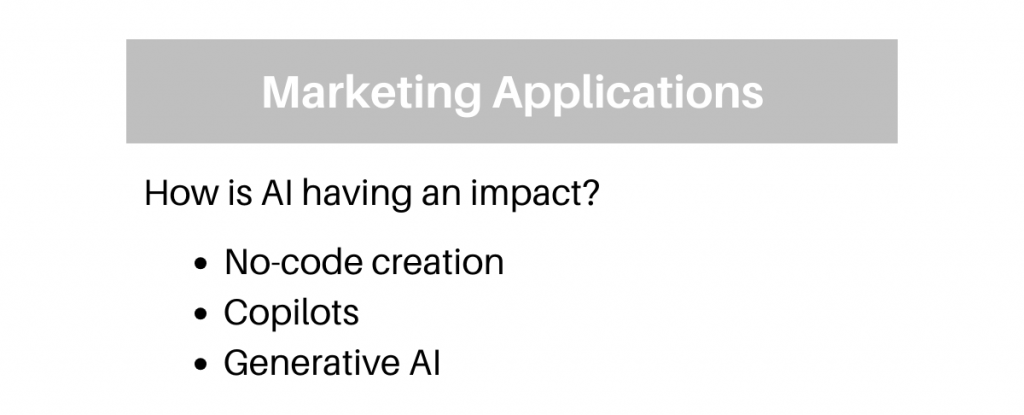
- No-code creation – Want a website, a mobile app, or a clever piece of software to gamify a CTA? No problem. You no longer need to code. AI has created a revolution of marketing applications that can give you these things in minutes and generative AI is leading the way. ‘Text-to-anything’ as I like to call it, and soon ‘Voice-to-anything’ create the creative outputs that you used to rely on specialist coding skills for.
- Copilots – If you haven’t heard the phrase ‘copilots’ used in the same sentence as your favourite marketing tool this year, then quite frankly, you’re probably not in marketing. Possibly one of the most used phrases in marketing tools this year, AI copilots are invaluable to marketers, helping to save time, improve efficiency, and create more personalized and effective marketing campaigns.
- Generative AI – This really wouldn’t be a beginner’s guide to AI tools for marketing without reference to Gen AI. Everyone is at it. It seems we will all be talking to our computers this time next year. Although Gen AI is still not good enough to command control of some more complex requests that you may need your marketing tool to action, this natural language interface is already being deployed in content generation, ad creation, email marketing, social media marketing, customer segmentation and campaign optimization to mention but a few.
The key to success with Gen AI is in prompt engineering. You can very easily train Gen AI tools like Bard or Chat GPT to understand your required writing style and even your persona and their abilities are developing at a tremendous rate. However, with Google keen to demote plagiarism content down the ranking, I suggest that all content is always edited by a human.
“Sixty-three percent of marketing leaders are planning to invest in generative AI in the next 24 months according to a survey from Gartner”
Gartner
Emerging Tech
Emerging tech has the ability to move down the stack as the value and your familiarity with the tech grows, but not to substitute more fundamental tiers at such an early stage. This tier includes the newest and most innovative MarTech tools and technologies. This can include tools such as augmented reality, virtual reality, and blockchain. AI is all about creating new opportunities for marketers to reach and engage with their customers. For example, AI-powered chatbots can be used to provide customer service and support 24/7. AI marketing tools can also be used to create personalized marketing messages and experiences for individual customers. We’ve looked at the influence of AI on emerging technologies as we’ve progressed through this article. However, let’s take a look at a few we’ve not covered.
How is AI having an impact?
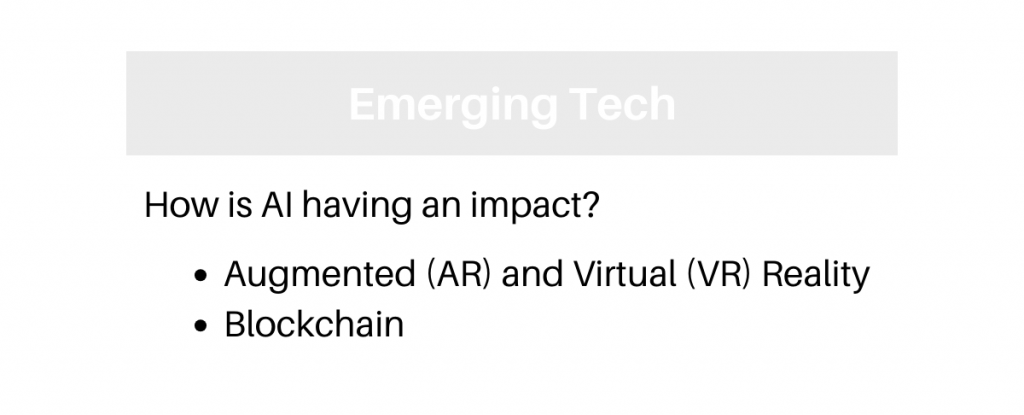
- Augmented (AR) and Virtual (VR) Reality have been hovering around marketers for a while, promising to be an all-new way of engaging your audiences with product recommendations and living room experiences. Now, AI is creating more dynamic and interactive AR experiences. AI can be used to create AR experiences that are more dynamic and interactive. For example, AI can be used to create AR experiences that respond to the user’s environment or that adapt to the user’s behaviour. This can make AR experiences more engaging and fun for users. Imagine the uses in physical sectors such as Retail or Leisure to deliver better customer experiences that engage customers longer and even increase spending. AI is being used to develop AR apps that allow users to personalise products and visualize products in their own homes before they buy them. Brands such as Amazon are already deploying this This is helping consumers to make more informed purchase decisions. AI will also have a huge influence on how we create and consume social media. AR social media apps that allow users to create and share AR experiences with their friends and followers will make social media more interactive and engaging.
- Blockchain. Whether Blockchain ever has its day in the martech stack is yet to be understood. At its heart, the benefits of blockchain are security, scalability and efficiency. AI is making blockchain networks more secure, scalable, efficient, and as such, useful. Predictions for Blockchain’s influence in marketing include enabling the distribution of content to be tracked and ensuring that it is not being plagiarized. There are some brands trailblazing in this space. IBM is using blockchain to create such a content marketing platform which promises more security and transparency for content marketers.
The pitfalls of implementing AI marketing tools
Martech isn’t always plain sailing. You can get your martech stack wrong, as much as you can get it right. When new technologies come along like AI, which promise to do so much more, the stakes of getting it wrong are even higher.
For example, without the right testing, integration planning and roll-out support for users, new technologies can often be implemented too fast and any technology that sits in the workflow of delivering customer experience will ultimately be experienced by customers if you get it wrong.
You can also get sucked up by the hype of new technology like AI and its impact on marketing tools. If you don’t understand the outcomes you are aiming for before you implement new martech, then you could be leaving yourself open for a fall. Knowing what the outcomes should be in advance, and having milestones in place could help you avoid costly mistakes, and also help you measure the ROI of implementation.
Lastly, it can be damaging to not acknowledge your starting point correctly when deploying new martech.. You need to know where you are starting from before you know the best route on how to get where your desired outcome tells you you need to be. If you don’t know where you started, how can you measure milestones and ultimate success?
The impact on marketers
AI marketing tools are having a significant impact on the role of marketers. It is automating tasks, freeing up marketers to focus on more strategic initiatives, and providing insights that can help them to improve their campaigns.
Some of the specific ways that AI-driven marketing is impacting the jobs of marketers:
- A marketing manager at a retail company could use AI marketing tools to automate her email marketing campaigns. This could free her up to focus on developing new marketing strategies and creating relationships with key customers.
- A social media marketer at a tech startup could use AI to analyze social media data and identify trends and patterns. This information could help her to create more effective social media campaigns.
- A growth manager at a SaaS company could use AI to predict customer behaviour and deliver the right message at the right time. This would help her to increase customer acquisition rates and reduce churn.
The future of AI marketing tools
There is a clear future for AI in marketing and marketers using AI. AI is being positioned as an additive to a marketer’s role, it does not replace the marketer. Those who want to succeed in the future need to be prepared to adapt to the changing landscape. They need to develop new skills and knowledge in order to work effectively with AI. They also need to be able to think strategically and creatively about how to use AI to achieve their marketing goals.
CMOs will need to balance AI pursuits with the need to maximize returns on existing investments. The two are yet to prove their relationship! Seventy-one per cent of CMOs said they lack the budget to fully execute their strategy in 2023, according to a Gartner.
McKinsey Global Institute’s “The Future of Work: Automation, Employment, and Productivity” (2017)” found that 42% of marketing tasks can be automated using AI. This includes tasks such as data entry, email marketing, and social media marketing yet a recent study by Forrester found that 63% of marketers believe that AI is creating new opportunities for them to reach and engage with their customers.
As always, don’t fear AI. Embrace it!
What AI was used for this post?
- Google Bard – Planning and Outline
- Google Bard – Article research
- Bing Image Creator – ‘Create a photo to use behind the words ‘A beginners guide to ai marketing tools’